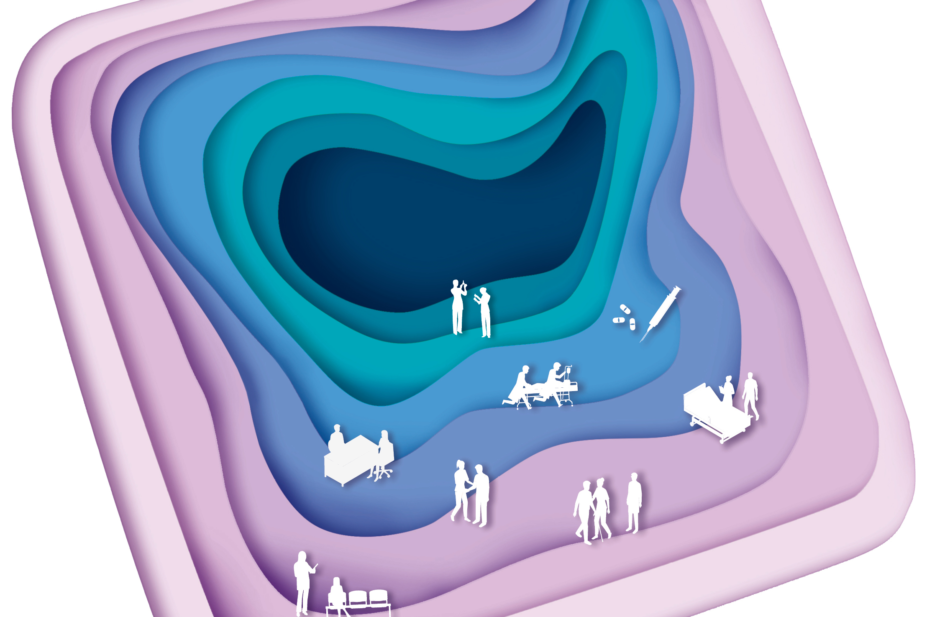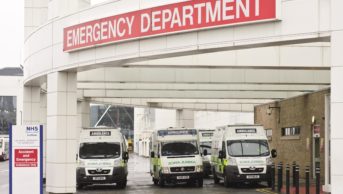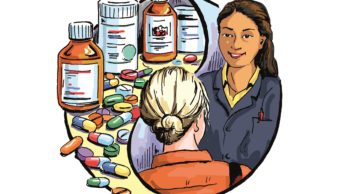
JL / The Pharmaceutical Journal
In 2016, hospital pharmacy departments in England were challenged with increasing the proportion of time pharmacists spend on clinical activities. And, according to NHS Benchmarking Network data shared with The Pharmaceutical Journal, pharmacy teams in acute hospitals have risen to this challenge, increasing the percentage of time pharmacists spend on clinical activities from an average of 66% (20–97%) in 2016 to 75% (41–97%) in 2018[1]
(see Infographic). This increase represents significant progress towards meeting the ambitious target of 80% by 2020, set by Lord Carter in his 2016 review of hospital efficiency[2]
.
The Carter review, as it is now known, outlined a wide-ranging programme of transformative change for NHS acute hospital pharmacy departments, stretching from workforce and infrastructure to medicines procurement (see Panel 1). Each pharmacy team in England developed a Hospital Pharmacy Transformation Plan detailing how they would implement these changes, and although many of these initiatives were already on the horizon for hospitals, pharmacists say that the Carter review provided a platform to drive the transformation.
But while some trusts are charging ahead with over 90% of pharmacists’ time being spent undertaking clinical activities, some are still lagging behind with percentages in the 40s or 50s.
Panel 1: The Carter review
In his review, published on 5 February 2016, Lord Carter tasked pharmacy departments in acute NHS trusts in England with making £800m in savings by 2020 (see Panel 2).
The review highlighted variations among hospitals in the number of prescribing pharmacists and the total cost of pharmacy and medicines. To address this, Lord Carter laid out a series of targets, emphasising the need for a greater focus on clinical roles for pharmacists and pharmacy technicians.
Among these targets was a call for more than 80% of pharmacist resource to be used for direct medicines optimisations activities, medicines governance and safety remits, and for 50% of hospital pharmacists to be actively prescribing, by 2020.
Lord Carter also made the case for trusts to adopt digital information systems, such as those for electronic prescribing and medicines administration, and electronic processing of orders and invoices. Other recommendations were for trusts to reduce medicine stock-holding days from 20 to 15, and deliveries to less than 5 per day, and to consider outsourcing outpatient dispensing services.
Becoming more clinical
NHS Benchmarking Network figures for Barts Health NHS Trust highlight that, in 2018, an average of 90% of pharmacist time was spent on clinical work, one of the highest levels in the country.
But this wasn’t always the case. Before the Carter review, the percentage of pharmacist time spent on direct patient care at Barts was around the 50–60% mark, according to Sotiris Antoniou, consultant pharmacist in cardiovascular medicine and site lead pharmacist at St Bartholomew’s Hospital in central London. He says that the “major enabler” of this huge increase was moving the dispensary from the basement to ward-level satellites.

Source: Courtesy of Sotiris Antoniou
Sotiris Antoniou, consultant pharmacist in cardiovascular medicine and site lead pharmacist at St Bartholomew’s Hospital, says an average of 90% of pharmacist time is now spent on clinical work at the hospital
“In many places … [pharmacy staff] do the wards for a couple of hours and then run down to the pharmacy, usually in the basement,” says Antoniou.
We wanted to change that to make pharmacy more of a patient-facing service, so most of our pharmacists are now based on the wards where we have ward-based satellite pharmacies
“We wanted to change that to make pharmacy more of a patient-facing service. So, most of our pharmacists are now based on the wards where we have ward-based satellite pharmacies.
“This has translated into a reduction in people waiting for their medicines.”
Antoniou explains that Barts Health NHS Trust was fortunate because the Carter review coincided with a merger of the Barts’s cardiac services with that of the London Chest Hospital and the Heart Hospital, to develop the £234m Barts Heart Centre. As part of the merger discussions, Antoniou and his team submitted proposals to extend the hospital pharmacy service to seven days per week, in line with Lord Carter’s recommendations.
“We felt that we could provide a better service for patients by [providing clinical pharmacy services] seven days a week,” explains Antoniou. “We were [already] around the table as part of the merger discussions [but] we didn’t just say ‘do a traditional seven-day service’, we wanted to make it a seven-day clinical pharmacy service.”
The Saturday and Sunday services at the Barts Heart Centre are now running from 9:00 to 17:15 and all emergencies, new admissions and discharges are reviewed by a pharmacist.
We’re in a situation where we were already quite good but not hitting the Carter review’s 80% target
At University Hospital Southampton NHS Foundation Trust, pharmacists were already spending around 77% of their time on clinical activities. But, two years on, and with the proportion of time spent on clinical services much the same, Sue Ladds, chief pharmacist and lead for clinical support services, says it is difficult to know how they can increase that percentage.

Source: Courtesy of Sue Ladds
Sue Ladds, chief pharmacist and lead for clinical support services at University Hospital Southampton NHS Foundation Trust, says the trust is pursuing a shared medicines procurement and distribution hub
“We’re in a situation where we were already quite good but not hitting [the Carter review’s 80%] target,” she explains.
“We do have specialist pharmacists in roles that don’t [necessarily] have to be pharmacists — such as our quality assurance senior post, our educational training lead and our IT lead. Not every pharmacist will want to be a clinical patient-facing pharmacist.
“It’s quite good to have those opportunities for pharmacists if they want them — if they don’t want to be a clinical pharmacist,” she adds.
But the trust has come up with a potential solution, which focuses on its aseptic unit, where pharmacists still carry out the final check of products.
“We’ve been working to develop a training and competency assessment for our pharmacy technicians to do that final checking process,” Ladds explains.
By releasing a couple of pharmacists, she says, it could make the required difference to the trust’s benchmarking figures.
Warranted variation
Some pharmacy teams in specialist organisations are also finding Lord Carter’s 80% target difficult. Jatinder Harchowal, chief pharmacist at London’s Royal Marsden NHS Foundation Trust, points out that clinical activity can be subjective and is therefore difficult to measure. In his team, a quarter of pharmacists are focused on research and development, in particular supporting clinical trials across the organisation.
“Would you class that as clinical activity? Perhaps partly but not fully,” he suggests. “But it’s essential for what we need in our organisation. So that’s an example of where we might have warranted variation [to other trusts].”
There are some specific differences with some specialist organisations, like the Royal Marsden, so there are other measures that we might want to look at … that might not fall into the original Carter metrics
Harchowal explains that, at the Royal Marsden Hospital, where the focus is on cancer services, pharmacists are spending 50–60% of their time on clinical activities, which is still a substantial way off target despite an increase from the 40–45% figures recorded before the Carter review was published.

Source: Courtesy of Jatinder Harchowal
Jatinder Harchowal, chief pharmacist at London’s Royal Marsden NHS Foundation Trust, says that clinical activity can be subjective and is therefore difficult to measure
“There are some specific differences with some specialist organisations, like [the Royal Marsden], so there are other measures that we might want to look at … that might not fall into the original Carter metrics.”
Harchowal describes Lord Carter’s 80% target as “challenging”, but acknowledges that working in this way does provide a huge benefit to patients. The trust is currently looking at how to increase clinical pharmacy presence at weekends, with plans to actively change the way pharmacists work by early 2019. In addition, the Royal Marsden Hospital has been trying to work beyond the boundaries of the hospital walls.
Since the Carter review targets were set, sustainability and transformation partnerships (STPs) and integrated care systems have been established to encourage a greater degree of collaboration on supporting infrastructure for the provision of pharmacy services, with the aim of freeing up pharmacists’ time and saving money.
“Rather than just looking at providing all of our services as a single organisation, we’re working a lot more across our two different STP areas [in] North West and South West London,” says Harchowal.
The aim, he says, is to share best practice and look at how some services might be provided jointly. “[We are] looking at a very broad supply chain initiative, which will range from having different ways in which [intravenous] fluids are provided to our hospitals [to] exploring … a shared procurement distribution service.”
Collaborative working
One area where hospital pharmacy is setting the standard for collaboration in line with the Carter review is Leeds.
We’re working together across nine trusts in Yorkshire to change the way we handle stock medicines
“We’re working together across nine trusts in Yorkshire to change the way we handle stock medicines,” says Liz Kay, clinical director of medicines management and pharmacy services at Leeds Teaching Hospitals NHS Trust.

Source: Courtesy of Liz Kay
Liz Kay, clinical director of medicines management and pharmacy services at Leeds Teaching Hospitals NHS Trust, says the trust began rolling out its electronic prescribing system two years ago and has now finished its inpatient e-prescribing roll out
“We’re looking to collaborate with a single warehouse [and a] single ordering supply system, enabling us to make our delivery schedules much more efficient and increase our electronic trading.”
The collaboration will result in a centralised hub to hold stock, process the orders, pack the stock for all the relevant clinical areas and deliver it in the most efficient way, all of which should free up pharmacy time.
“It’s about pushing us from a more manual process to a much more automated process,” says Kay.
University Hospital Southampton NHS Foundation Trust also plans to pursue its own shared medicines procurement and distribution hub, in collaboration with Portsmouth Hospitals NHS Trust and the Isle of Wight NHS Trust.
“We’re looking at that to be hosted by Portsmouth … so Portsmouth would buy the medicines for all three hospitals and then we would buy from them,” explains Ladds.
“We’d still send them the list of what we need, but instead of delivering that to us in a massive great big thing [for us to] split [up]… Portsmouth would send it to us as an order for a [particular] ward — direct to ward delivery.”
Ladds says that she expects the hub to be set up in the next year or so, releasing some of the trust’s non-registered workforce, such as pharmacy support workers. This would enable them to play more of a role in medicines optimisation and in supporting pharmacists and pharmacy technicians. She envisages it will be another two or three years before the trust sees the impact of “the big transformational changes”.
“I think if we do manage to pull off the shared store, it will completely change the way we work [at Southampton],” she explains. But she admits that this will only make a difference if the trust decides to invest in the workforce that is saved through the shared store, rather than losing it.
Prescribing services
Another way in which trusts are adapting the pharmacy skill mix to make efficiencies is to increase the number of pharmacist prescribers.
According to the NHS Benchmarking Network, the proportion of pharmacists in acute trusts qualified to prescribe has increased from 24% in 2016 to 38% in 2018. However, only 61% of those qualified to prescribe are doing so routinely (see Infographic).
At Barts Health NHS Trust there is a policy that all pharmacists become independent prescribers. In Leeds, it is a similar story, with pharmacists now taking on prescribing that was formerly carried out by junior doctors.
“Many pharmacists prescribe on admission or in surgical areas where we’re prescribing for pre-admission patients,” says Kay. “That’s grown just in this short period of time.”
The prescribing course is expensive, it’s hard to find the clinical supervisors and it’s hard to release people to do the training
But Ladds says that getting to Lord Carter’s target of 50% of pharmacists being prescribers is a challenge. “If you’re thinking about eligible pharmacists, you’re immediately ruling out anyone who has been qualified for less than two years.
“The prescribing course is expensive, it’s hard to find the clinical supervisors and it’s hard to release people to do the training,” she explains. “You also have to have a combination of a clinical area where there’s a need and a pharmacist who’s at the right point in their development.”
Ladds adds that the trust is on a trajectory to improve but isn’t trying to “desperately hit” the target.
“I think the principles within the report were spot on and are certainly what we’re aiming for in terms of strategy, [but] hitting the targets doesn’t drive me every day,” she adds.
Electronic prescribing is one area in which there is considerable variation across the country. Barts is only just introducing it, whereas Southampton already had electronic prescribing in place before the Carter review.
At the Royal Marsden Hospital, electronic prescribing is in place for chemotherapy services but not at ward level. “That’s our next very large project,” says Harchowal.
“We’re going to get a brand new electronic patient record, which will include e-prescribing … we’ll go out in early 2019 to look at purchasing a new system.”
In Leeds, the trust began rolling out its electronic prescribing system two years ago and has now finished its inpatient e-prescribing roll out, progress Kay describes as “huge”.
In February 2018, then secretary of state for health and social care Jeremy Hunt announced £75m of additional funding to support the increased use of electronic prescribing and medicines administration as a direct result of Lord Carter’s recommendations, as well as the World Health Organization’s global challenge on medication safety[3]
.
“[A total of] £16m of this funding has already been allocated to trusts across the country and bidding for 2019/2020 funding is currently open, with applications closing on 31 January 2019,” says Andrew Davies, director of hospital pharmacy at NHS Improvement.

Source: Courtesy of Andrew Davies
Andrew Davies, director of hospital pharmacy at NHS Improvement, says that hospital pharmacy teams are on schedule to deliver savings way beyond the challenging target set by Lord Carter
A trigger for change
The challenge in any pharmacy department is recognising the NHS’s finite resources. Ladds says that a lot of the major transformational work at Southampton has proved difficult because of the need for capital investment.
The workload we’re coping with continues to escalate and meeting demand is a challenge; we’ve grown our workforce numbers substantially but the hospital wants us to do more and more
Consequently, NHS trusts have to demonstrate that investment in a certain area will give a good return. “If you’ve got big delays because [patients are] waiting for medicines, you may find that [the trust will] be willing to invest in [something] that improves the length of stay of patients,” says Antoniou.
Kay adds that workload volume is an increasing challenge. “The workload we’re coping with continues to escalate and meeting demand is a challenge. We’ve grown our workforce numbers substantially but the hospital wants us to do more and more,” she says.
As well as presenting challenges, the Carter review appears to have triggered a switch in focus within hospital pharmacy and a sense of urgency to initiate changes that may have been on the cards for a while.
According to Davies, an internal NHS Improvement report presented in 2018 to Keith Ridge, chief pharmaceutical officer for England, showed just how much pharmacy teams had engaged with the review and progressed in taking the recommendations forward.
Harchowal says that pharmacy teams were worried about some of the Carter review’s metrics at first, but now they are comfortable with the concept of clinical services and medicines optimisation being central to what they do.
The biggest impact so far has been in breaking down the barriers between different areas, such as STPs, he believes. “Conversations across areas are happening with a lot more focus and support. I don’t think that was taking place two or three years ago, not to this level.
“We’re all grappling with those same challenges, we all learn from each other. We share best practice and increasingly now we’re thinking, ‘do we all need to provide these services?’” he says. “I’m not sure we need to, I think we need to share more.”
The Carter review was a tool for us to help drive the agenda that was already there
Ladds explains that many of the recommendations in the Carter review — increasing clinical pharmacy and prescribers, providing seven-day clinical pharmacy services and enabling pharmacy technicians to release pharmacists — were already in the trust’s plan. However, the review prompted the trust to rethink its medicine procurement and distribution.
“If we’d tried to do that without the Carter review it would have been really tricky. The Carter review was a tool for us to help drive the agenda that was already there,” she says.
Kay says that the Carter review’s metrics fitted with what her trust was already doing and, consequently, changes at her trust would have happened anyway. However, she agrees that the review has given the trust an “extra push” in the right direction.
“[It has provided] an opportunity to talk about what we’re doing with senior people in our organisation as well, which is always a good thing.”
Panel 2: Financial savings
In his report, Lord Carter identified potential savings that could be made by the NHS from reducing unwarranted variation — up to £5bn per year by 2020–2021, with £0.8bn of this coming from “hospital pharmacy and medicines optimisation”.
According to Andrew Davies, director of hospital pharmacy at NHS Improvement, £118m of savings were identified in 2016–2017 and £324m in 2017–2018.
“We can see that hospital teams have delivered £442m saving to the NHS recurrently already and we have £200m a year target for the next two years,” he says. “So by the end of the period, the savings will be way beyond the challenging target set by Lord Carter.”
References
[1] Lord Carter of Coles. Operational productivity and performance in English NHS acute hospitals: Unwarranted variations. An independent report for the Department of Health by Lord Carter of Coles; 2016. Available at: https://assets.publishing.service.gov.uk/government/uploads/system/uploads/attachment_data/file/499229/Operational_productivity_A.pdf (accessed January 2019)
[2] NHS Benchmarking Network. Pharmacy and medicines optimisation benchmarking 2018, summary report; 2018. Available at: https://www.nhsbenchmarking.nhs.uk/news/2018-pharmacy-and-medicines-optimisation-project-results-published (accessed January 2019)
[3] World Health Organization. Medication without harm: global patient safety challenge on medication safety. Geneva; 2017. Available at: http://apps.who.int/iris/bitstream/handle/10665/255263/WHO-HIS-SDS-2017.6-eng.pdf?sequence=1 (accessed January 2019)


